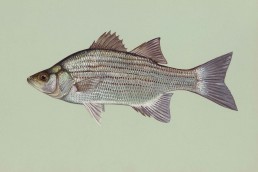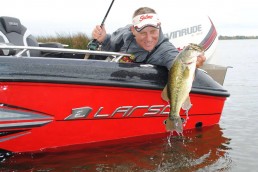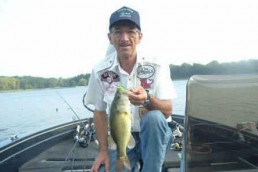SHARE THIS POST
There is some great fishing on our rivers in the Midwest that contain white bass. Many seem to think it’s over for this species when the spring run finishes. Well, the truth is you can enjoy catching them throughout the summer with a little preparation and planning.
For some unknown reason, many folks I talk to about fishing for white bass this season seem to believe the theory that when the weather is hot, the whites bass don’t bite. That’s nonsense. The problem many anglers are experiencing is that they’re simply fishing in locations where the white bass aren’t living. Due to the much warmer water conditions we are experiencing now, the fish have simply moved to better locations.
Deep-water locations are where these fish have moved to; it’s their comfort zone in rivers for the season. These are those areas where the schools of big white bass can spend their time in cooler waters that also contain good numbers of baitfish for them to feed on.
So now that we are thinking deep water, how should you go about catching yourself a nice cooler of white bass?
Are you enjoying this post?
You can be among the first to get the latest info on where to go, what to use and how to use it!
When starting your search, it’s always a great idea to have a good map of the river and look it over before you hit the water. You’re going to want to look for areas such as the outsides of river bends, steep, tapering shorelines that drop off into deep water fast, and also rocky structure located in the deeper water. White bass congregate in these locations and you will usually find the large schools holding there. Use your depth finder to locate and verify the area and what it is as shown on the map. The reason is, in the river environment with ever-constant current, areas can see changes in its topography quickly. What might be shown on your map may not be accurate. But depending on how advanced your sonar or finders are, you can really pinpoint these locations. If you have GPS and can locate these areas, waypoint them for future reference.
When it comes to presentations in deep water, one of the easiest and most successful methods is to vertical-jig some type of jigging spoon. Make sure the jigging spoon is heavy enough to reach the bottom easily. This is something you will have to determine on the water due to present conditions. Current and the depth being fished are the main factors here. You will want to go heavy enough to maintain good lure control but not so heavy as to make the lure sink way too fast. Like I said, you will have to experiment. Second, use a jigging spoon of some type that has a lot of flash that will get a fish’s attention when you’re working it in its zone. Experiment with the speed of your jigging motion until you find out how aggressive the fish are. Sometimes they want it fast, and other times a subtle motion will do the trick. If you like, try jigging round head-style jigs with big, bushy hair tails. White has been an excellent color for this type of deep-water fishing. Again, vary your jigging motion until you know what the fish want.
Finally, as a bonus, take a nice lively minnow or nightcrawler and lower it down into the area as if you’re using a deadstick rod. Make sure it’s secured so it doesn’t get pulled overboard by a big strike. You’ll be surprised how many fish you can catch using this deadstick method.
Don’t fall into the old way of thinking that those big white bass aren’t catchable in rivers this summer. These fish are in there, they’re hungry, and they’re waiting for you.
MWO
SHARE THIS POST
Did you enjoy this post?
You can be among the first to get the latest info on where to go, what to use and how to use it!
Mike Cyze
Mike Cyze has been called one of the most knowledgeable multispecies river anglers in the country. His ability to catch fish under the challenging conditions encountered in the river environment, combined with his overall fishing knowledge, has earned him recognition as a true Mississippi River Expert. Contact him at: lastcast13@yahoo.com.



